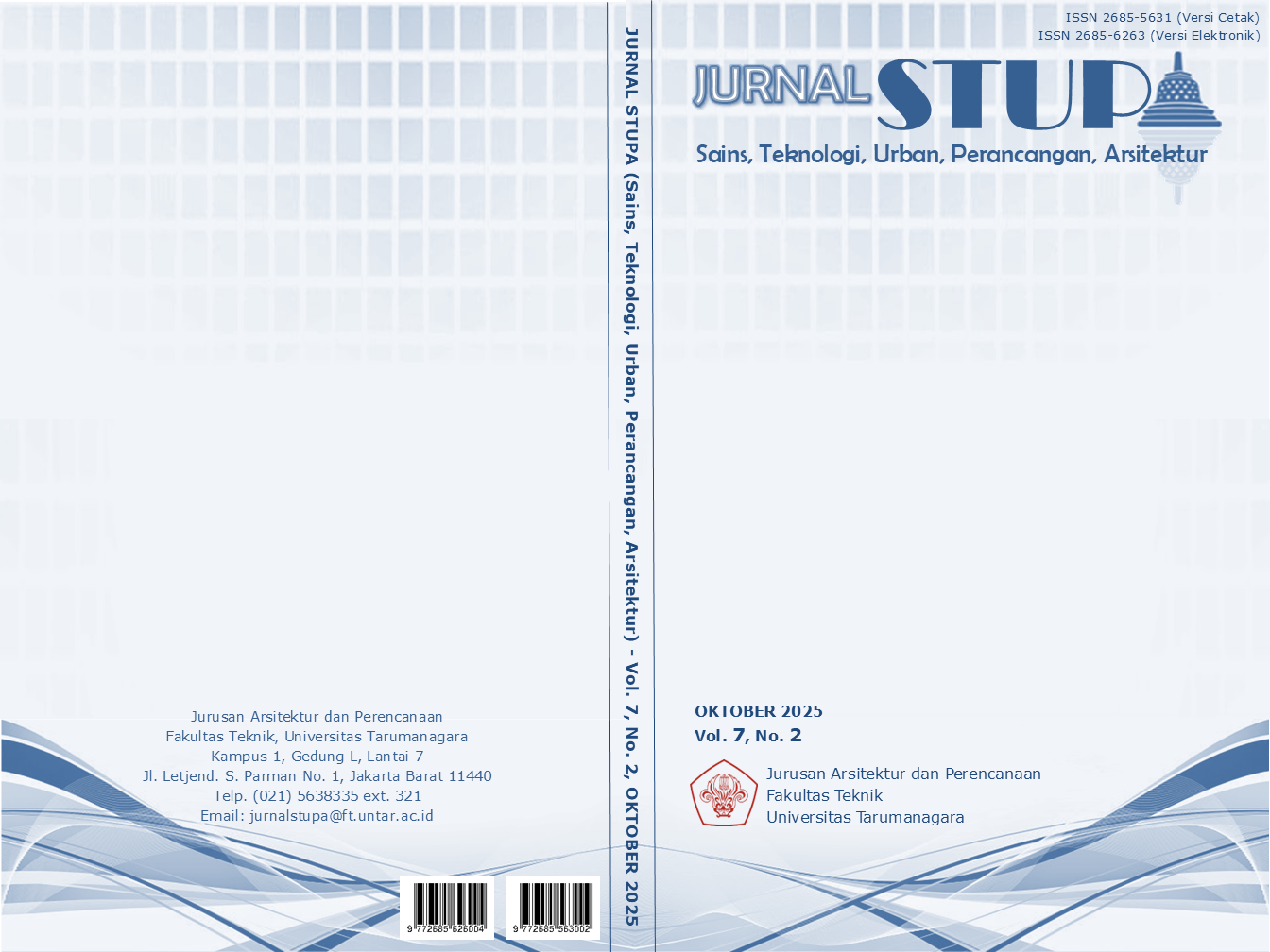PENERAPAN METODE DESAIN DENGAN KONSEP REGENERATIF DALAM PASAR GROGOL, JAKARTA BARAT
Main Article Content
Abstract
Pasar Grogol in West Jakarta aims to overcome various challenges such as declining visitor numbers, poor building functionality, and lack of innovation in management. The aim of this study is to improve the local economy and restore the role of the market building as an important social area. The project will apply a regenerative design method to revive the market in a sustainable way, with the strategy to be applied is to create a multifunctional space, where the market not only functions as a place to sell, but also as an area, community and open space. This strategy will increase visitor attraction, and engage the local community through active participation. Sustainability is also a key focus, with an effective waste management system, use of renewable energy, and greening of the market area. By combining the principles of community participation and green space technology, Pasar Grogol has the potential to transform into a modern market that maintains traditional values. As a result, Pasar Grogol will not only grow more vibrant, but also benefit the environment. This research explores and applies regenerative design methods in Pasar Grogol. This research uses a qualitative method with data collection through observation. To improve the sustainability of the market, this project will innovate by combining design techniques with regenerative principles. Due to their ability to build a peaceful, mutually beneficial, and sustainable ecology, bees are the model organism from which regenerative ideas are derived.
Keywords: Community; Market; Observation; Regenerative; Sustainability
Abstrak
Pasar Grogol di Jakarta Barat bertujuan untuk mengatasi berbagai tantangan seperti menurunnya jumlah pengunjung, fungsi bangunan yang kurang baik, dan kurangnya inovasi dalam pengelolaan. Tujuan penelitian ini untuk meningkatkan ekonomi lokal dan mengembalikan peran bangunan pasar sebagai area sosial yang penting. Proyek ini akan menerapkan metode desain dengan konsep regeneratif untuk menghidupkan kembali pasar dengan cara yang berkelanjutan, dengan strategi yang akan diterapkan adalah menciptakan ruang multifungsi, di mana pasar tidak hanya berfungsi sebagai tempat berjualan, namun juga sebagai area, komunitas dan ruang terbuka. Strategi ini akan meningkatkan daya tarik pengunjung, dan melibatkan masyarakat setempat melalui partisipasi aktif. Dengan keberlanjutan juga menjadi fokus utama, dengan adanya sistem pengelolaan sampah yang efektif, penggunaan energi terbarukan, dan penghijauan area pasar. Dengan menggabungkan prinsip-prinsip partisipasi masyarakat dan teknologi ruang hijau, Pasar Grogol memiliki potensi untuk bertransformasi menjadi pasar modern yang mempertahankan nilai-nilai tradisional. Hasilnya, Pasar Grogol tidak hanya akan tumbuh lebih hidup, tetapi juga bermanfaat bagi lingkungan. Penelitian ini mengeksplorasi dan menerapkan metode desain regeneratif di Pasar Grogol. Penelitian ini menggunakan dengan metode kualitatif dengan pengumpulan data melalui observasi. Untuk meningkatkan keberlanjutan pasar, proyek ini akan berinovasi dengan menggabungkan teknik desain dengan prinsip-prinsip regeneratif. Karena kemampuannya untuk membangun ekologi yang damai, saling menguntungkan, dan berkelanjutan, lebah menjadi model organisme yang menjadi sumber gagasan regeneratif.
Article Details

This work is licensed under a Creative Commons Attribution-NonCommercial-ShareAlike 4.0 International License.
This work is licensed under a Jurnal Sains, Teknologi, Urban, Perancangan, Arsitektur/ STUPA Creative Commons Attribution-NonCommercial-ShareAlike 4.0 International LicenseReferences
Attia, S. (2018). Design Principles of Regenerative Design. 19–32. https://doi.org/10.1007/978 3-319-66718-8_4
Baper, S. Y., Khayat, M., & Hasan, L. (2020). Towards Regenerative Architecture: Material Effectiveness. International Journal of Technology, 11(4), 722–731. https://doi.org/10.14716/ijtech.v11i4.2631
Dumitrescu, L., Bliuc, I., Baran, I., Pescaru, R.-A., & Parincu, P.-D. (2021). Regenerative Design - General Principles and Implementation Strategies in Building Design. Bulletin of the Polytechnic Institute of Iași. Construction. Architecture Section, 67(4), 1–21. https://doi.org/10.2478/bipca-2021-0031
Fahmy, A., Abdou, A., & Ghoneem, M. (2019). Regenerative Architecture as a Paradigm for Enhancing the Urban Environment. Port-Said Engineering Research Journal, 23(2), 11–19. https://doi.org/10.21608/pserj.2019.49554
Hes, D., Hernandez-Santin, C., Beer, T., & Lo, L. (2020). A New Model for Place Development – Bringing Together Regenerative and Placemaking Processes. 321–332. https://doi.org/10.1007/978-3-030-37635-2_22
Kupita, W., Rahadi, D., & Bintoro, W. (2012). IMPLEMENTASI KEBIJAKAN ZONASI PASAR TRADISIONAL DAN PASAR MODERN (STUDI DI KABUPATEN PURBALINGGA). www.ireyogya.org
M. Pedersen Zari & J.B. Storey. (2007). An ecosystem based biomimetic theory for a regenerative built environment.
Muliarta, I. N., Hariani, C. Y., Wahyuni, N. M. I., & Rismayanti, A. A. T. (2023). Study of Potential Food Waste in Zero Waste Cities Area- Saridewi, Denpasar-Bali. Jurnal Penelitian Pendidikan IPA, 9(5), 2595–2603. https://doi.org/10.29303/jppipa.v9i5.3019
Oppusunggu, R. E., Tjoeputri, M., & Katoppo, M. L. (2019). A STUDY OF URBAN PLACEMAKING EVOLUTION CHANGES AT PASAR SANTA JAKARTA. International Journal on Livable Space, 3(1), 35–52. https://doi.org/10.25105/livas.v3i1.3900
Prestianti, I., Baharuddin, M., & Sappewali, S. (2018). Uji Aktivitas Antibakteri Ekstrak Sarang Lebah Hutan (Apis dorsata) terhadap Pertumbuhan Staphylococcus aureus, Escherichia coli dan Pseudomonas aeruginosa. ALCHEMY Jurnal Penelitian Kimia, 14(2), 313. https://doi.org/10.20961/alchemy.14.2.13028.314-322
Szymkowiak, A., Antoniak, M. A., & Maślana, N. (2024). Changing consumer attitudes towards suboptimal foods: The effect of zero waste labeling. Food Quality and Preference, 114, 105095. https://doi.org/10.1016/J.FOODQUAL.2023.105095



